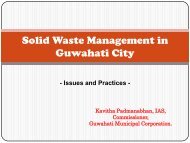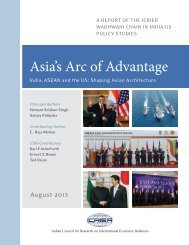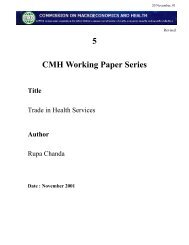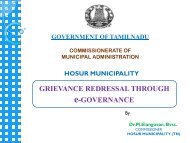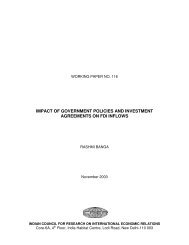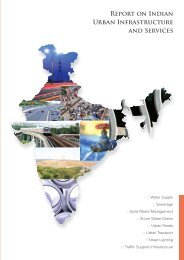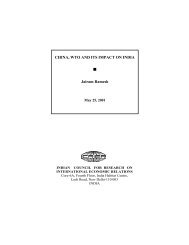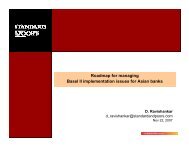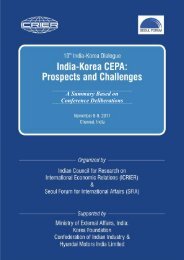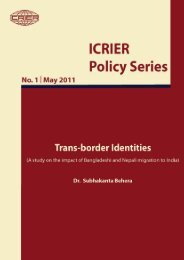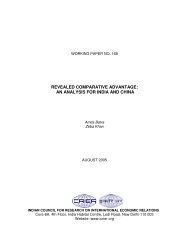Arpita Mukherjee Ramneet Goswami January 2009 - icrier
Arpita Mukherjee Ramneet Goswami January 2009 - icrier
Arpita Mukherjee Ramneet Goswami January 2009 - icrier
Create successful ePaper yourself
Turn your PDF publications into a flip-book with our unique Google optimized e-Paper software.
In 1997, the subsidiaries of CIL were restructured as financially independent competing<br />
units. 91 The prices of coking and higher-quality steam coal (quality grades A to C) were<br />
deregulated in 1996. In 2000, the Colliery Control Order, 1946 was replaced by the Colliery<br />
Control Order, 2000 which fully deregulated coal pricing. This allowed coal producing<br />
companies (CIL and SCCL) to fix their own prices and revise the same. 92<br />
The coal sector has been one of the few sectors which witnessed limited liberalization.<br />
The sector is dominated by PSUs and foreign/private players are only allowed to invest in<br />
captive coal mining. At present, there is a Screening Committee constituted of members<br />
from the Ministry of Coal and other ministries (such as railways, electricity and steel), the<br />
concerned state government, and the concerned coal subsidiary of CIL, among others that<br />
decides the allocation of captive coal blocks.<br />
3.1.2 Oil and Gas<br />
The Indian oil and gas sector is regulated by the Ministry of Petroleum and Natural Gas<br />
(MoPNG) and is dominated by PSUs. The Directorate General of Hydrocarbons (DGH)<br />
advises the government on all policy matters related to the upstream 93 segment while a<br />
Petroleum and Natural Gas Regulatory Board (PNGRB) has been set up under the PNGRB<br />
Act, 2006 to regulate the downstream 94 segment. Around 85 per cent of total crude oil<br />
production and 76 per cent of the total natural gas production are still in the hands of PSUs. 95<br />
The share of the private sector is gradually increasing. For instance, during 2006-07, oil and<br />
gas discoveries were dominated by private/joint ventures such as Cairn Energy India Limited<br />
and Reliance Industries Limited (RIL). 96 The refining segment is also dominated by National<br />
Oil Companies (NOCs), such as Indian Oil Corporation Limited (IOCL) at 32 per cent,<br />
Hindustan Petroleum Corporation Limited (HPCL) at 9 per cent, and Bharat Petroleum<br />
Corporation Limited (BPCL) at 13 per cent, and their subsidiaries. 97 Among private players,<br />
RIL has a 22 per cent share in the refining segment. 98 The retailing segment is dominated by<br />
NOCs (98 per cent), which have one of the strongest and largest distribution networks. There<br />
were 36,921 retail outlets in April 2008, of which the share of NOCs was 93 per cent. 99 In the<br />
natural gas segment, the Gas Authority of India Limited (GAIL) is the dominant player with a<br />
market share of 78 per cent in the gas transmission business and 70 per cent in the gas<br />
marketing business. 100 In the retail segment of natural gas, the company has key joint<br />
ventures such as the Mahanagar Gas Limited (a joint venture between British Gas and the<br />
government of Maharashtra) in Mumbai and Indraprastha Gas Limited (a joint venture<br />
between Bharat Petroleum Corporation Limited and the government of Delhi) in Delhi.<br />
91<br />
International Energy Agency (2002a)<br />
92<br />
In December 2004, CIL introduced e-auctions to allow traders and consumers to bid for their requirements<br />
from preferred sources, thus, bypassing the black market in coal and transferring the premium from those<br />
sales to the coal companies. However, the bulk of coal was still sold to the power sector at regulated rates<br />
well below those prevailing in the auction market. Based on this contention, in December, 2006 the Supreme<br />
Court of India considered e-auctions unconstitutional and banned CIL from undertaking this activity.<br />
Nevertheless, CIL has introduced a new on-line booking system, that is, e-booking on a first-come first-served<br />
basis.<br />
93<br />
Upstream activities cover E&P.<br />
94<br />
Downstream activities cover refining and managing distribution and marketing (processing, storage and<br />
transportation).<br />
95<br />
Calculated from Table 10 (pp.11), Ministry of Petroleum and Natural Gas (2008).<br />
96<br />
http://www.petrodril.com/major_discoveries.htm<br />
97<br />
PPAC (2008)<br />
98<br />
PPAC (2008)<br />
99<br />
Ministry of Petroleum and Natural Gas (2008) and PPAC (2008)<br />
100<br />
http://gail.nic.in/gailnewsite/businesses/gastransmission.html<br />
29



